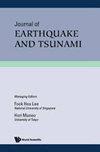柔性液柱阻尼器对脉冲型近断层地震结构振动的抑制
IF 2.1
4区 工程技术
Q2 GEOCHEMISTRY & GEOPHYSICS
引用次数: 0
摘要
脉冲型近断层(P-N)地震地面激励会对靠近地震断层的建成区的建筑物造成严重的破坏。高频率、长周期的高速度脉冲和甩动效应导致pn运动对刚性和柔性结构都提出了很高的要求。在各种被动控制装置中,液柱阻尼器是一种经济有效的控制装置,对远场地震作用下的柔性结构具有良好的控制效果。为了克服传统液晶显示器对刚性结构的不适应性,本文研究了柔性液晶显示器(CLCD)的柔性形式,并对其在P-N地震动作用下的刚性和柔性结构的振动控制进行了研究。本文从频域和时域两方面进行了研究。结果表明,CLCD可以成功地减轻结构对P-N地面运动的响应。在远场地震中,随着阻尼器参数的变化,响应减小的一些趋势与先前报道的不同。有趣的是,在柔性结构的情况下,虽然CLCD被发现是相当有效的,但传统的LCD实际上是无效的。本文章由计算机程序翻译,如有差异,请以英文原文为准。
Mitigation of Structural Vibrations Due to Pulse-Type-Near-Fault Earthquake by the Compliant Liquid Column Damper
Pulse-type-near-fault (P-N) earthquake ground excitations can inflict serious damage to structures in built-up areas situated close to seismic faults. The high frequency content, high velocity pulses of long period, and fling effects cause P-N motions to impose large demands on both stiff and flexible structures. Among various passive control devices, the liquid column damper (LCD) is economical and its effectiveness is well-established for flexible structures under far-field earthquake ground motions. In this paper, the compliant form of the LCD (CLCD), which was specially developed to overcome the nonapplicability of the conventional LCD to stiff structures, is investigated for the vibration control of both stiff and flexible structures subjected to P-N ground motions. The study is carried out both in the frequency and in the time domain. Results indicate that the CLCD is successful in mitigating structural response to P-N ground motions. Some of the trends of response reduction with damper parameters are found to be different from those earlier reported for far-field earthquakes. Interestingly, in the case of flexible structures, while the CLCD is found to be fairly effective, the conventional LCD is rendered practically ineffective.
求助全文
通过发布文献求助,成功后即可免费获取论文全文。
去求助
来源期刊

Journal of Earthquake and Tsunami
地学-地球化学与地球物理
CiteScore
2.60
自引率
13.30%
发文量
38
审稿时长
>12 weeks
期刊介绍:
Journal of Earthquake and Tsunami provides a common forum for scientists and engineers working in the areas of earthquakes and tsunamis to communicate and interact with one another and thereby enhance the opportunities for such cross-fertilization of ideas. The Journal publishes original papers pertaining to state-of-the-art research and development in Geological and Seismological Setting; Ground Motion, Site and Building Response; Tsunami Generation, Propagation, Damage and Mitigation, as well as Education and Risk Management following an earthquake or a tsunami.
We welcome papers in the following categories:
Geological and Seismological Aspects
Tectonics: (Geology - earth processes)
Fault processes and earthquake generation: seismology (earthquake processes)
Earthquake wave propagation: geophysics
Remote sensing
Earthquake Engineering
Geotechnical hazards and response
Effects on buildings and structures
Risk analysis and management
Retrofitting and remediation
Education and awareness
Material Behaviour
Soil
Reinforced concrete
Steel
Tsunamis
Tsunamigenic sources
Tsunami propagation: Physical oceanography
Run-up and damage: wave hydraulics.
 求助内容:
求助内容: 应助结果提醒方式:
应助结果提醒方式:


